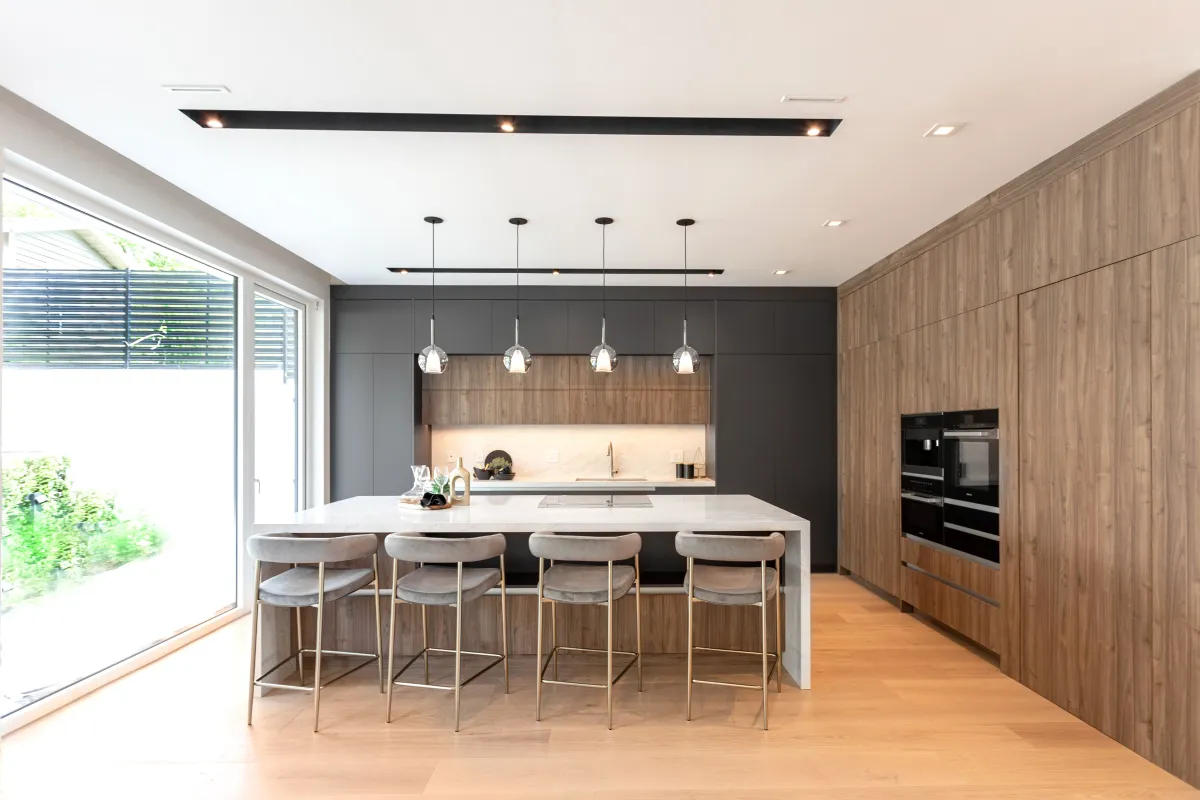
In recent years, the kitchen has evolved from a purely functional area to the centerpiece of the home—a place where form meets function, and style is just as important as practicality. One trend that’s rapidly gaining popularity among cabinet makers and interior designers alike is the combination of solid-colored cabinets with natural wood finishes. This approach brings together the best elements of contemporary and traditional design, resulting in kitchens that feel both current and timeless.
Mixing solid tones, such as crisp whites, deep blacks, or gentle greys, with the organic warmth of wood creates a striking visual contrast. The solid color provides a clean, modern foundation, while natural wood introduces unique grain patterns and tactile richness, ensuring every kitchen has its own personality. This blend caters to those seeking a minimalist aesthetic without sacrificing the cozy, inviting feel that wood brings.
For businesses involved in new construction or homeowners planning a renovation, this trend offers exceptional flexibility. It allows for easy customization, accommodating a wide range of styles—from urban chic to classic country. Moreover, kitchens designed with a thoughtful mix of finishes tend to hold their appeal over time, standing out as both stylish and enduring investments in any property.
Selecting the ideal combination of solid colors and wood finishes is essential for achieving a harmonious and functional kitchen. Begin by evaluating the natural light in your space. Lighter cabinet colors, such as whites and soft greys, can make smaller or darker kitchens appear brighter and more spacious, while deeper hues like navy or matte black add sophistication and create focal points in larger, open areas.
When it comes to wood finishes, options abound. Light woods like oak or maple evoke a Scandinavian vibe—airy, fresh, and calming. These pair beautifully with white or pastel cabinets, resulting in a look that’s crisp yet inviting. On the other hand, rich woods such as walnut or cherry provide a luxurious, bold counterpoint to darker cabinet colors, perfect for making a dramatic statement.
Balance is key. A popular technique is to use solid colors for upper cabinets and natural wood for the lower ones, or vice versa, ensuring the space feels grounded but not overwhelming. For those drawn to a more unified look, consider incorporating wood accents—like open shelving or a kitchen island—instead of full cabinetry. Ultimately, the best combination is one that complements your lifestyle, reflects your aesthetic tastes, and enhances the architecture of your home.
Achieving a cohesive kitchen design goes beyond selecting beautiful cabinets—it requires thoughtful coordination with the countertop. As any experienced cabinet maker will attest, the right pairing can elevate both elements, creating a seamless and sophisticated environment.
Start by considering the undertones of your cabinet colors and wood finishes. If your cabinets have cool undertones (like blue-grey or ash-toned wood), opt for countertops with similar hues—think white quartz with subtle grey veining or cool-toned granite. For warmer wood finishes, natural stone or engineered slabs in beige, cream, or brown tones can enhance the warmth and create a unified look.
Texture also plays a role. A matte cabinet finish pairs well with honed or leathered countertops, while glossy surfaces may complement high-polish stone or glass. Aim for contrast in either color or texture—but not both—to avoid a visually cluttered space.
Maintenance is another consideration. Some wood finishes and solid colors may show wear or stains more easily, so select countertop materials that are durable and easy to clean, such as quartz or high-pressure laminate, especially in high-traffic kitchens. Consulting with professionals ensures that your custom cabinets and countertops are not only visually aligned but also practical for everyday use.
Kitchen design is as much about expressing personality as it is about function. Blending solid-colored cabinets with natural wood allows for a spectrum of styles, each with its own unique charm. For those drawn to minimalism, Scandinavian-inspired kitchens remain a top choice. These spaces often feature white cabinets paired with pale oak or birch, ample natural light, and uncluttered surfaces, creating an environment that feels fresh, serene, and welcoming.
If you prefer a more dramatic effect, consider dark matte cabinets—such as charcoal, navy, or black—set against the rich, swirling grains of walnut or mahogany. This combination exudes modern luxury and makes a bold statement, particularly in spacious kitchens where contrast is celebrated rather than subdued.
Transitional kitchens blend the best of both worlds, mixing traditional shaker-style cabinets in solid colors with wood accents on islands or open shelving. For the adventurous, eclectic designs introduce pops of color—think soft green or blue cabinets with reclaimed wood details—resulting in a kitchen that’s both lively and harmonious.
Visual inspiration abounds, whether you’re planning a new build or refreshing an existing space. By drawing on these diverse design approaches, businesses and renovators can create kitchens that are not just on-trend, but truly reflective of their owners’ tastes.
The marriage of solid colors and natural wood in kitchen cabinetry is more than a fleeting trend—it’s a design philosophy that balances warmth, sophistication, and enduring value. By thoughtfully combining these elements, you create a kitchen that feels as inviting as it is stylish, offering a space where family and friends naturally gather.
Beyond aesthetics, this approach delivers practical benefits. Solid-colored cabinets are easy to maintain and refresh, while wood finishes introduce resilience and character that stand up to daily use. The adaptability of this design makes it suitable for everything from cozy home kitchens to high-traffic commercial spaces.
When planning your project, consider how your choices will age over time. Neutral solids and classic wood tones rarely go out of style, ensuring your kitchen remains appealing through changing trends and personal tastes. Collaborating with experienced cabinet makers and designers can help you navigate the vast array of materials, finishes, and layouts, resulting in a kitchen that’s not only beautiful but also perfectly suited to your needs.
Incorporating both solid colors and natural wood into your cabinet design is an investment in the heart of your home—one that pays dividends in comfort, function, and timeless appeal.